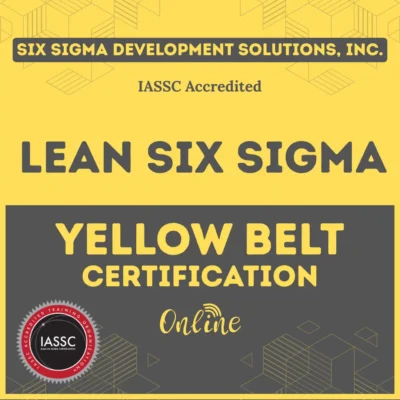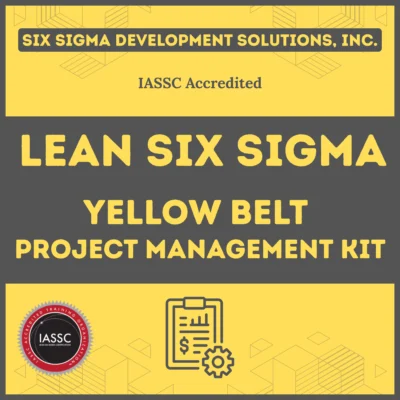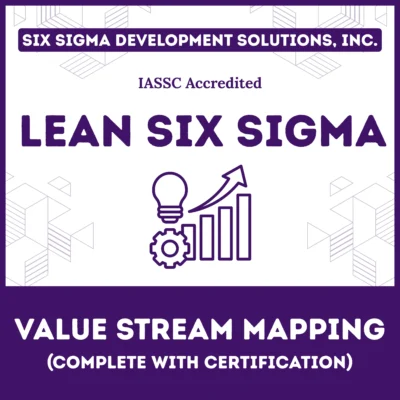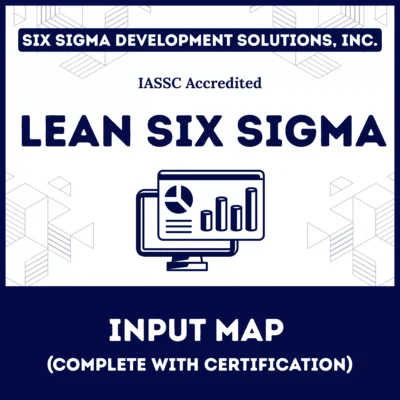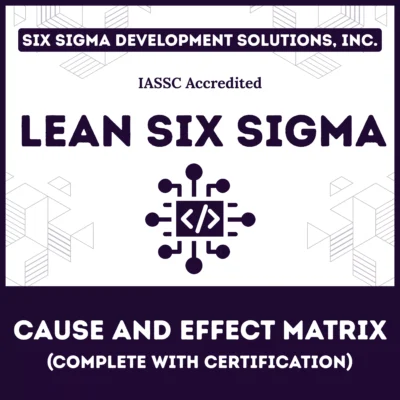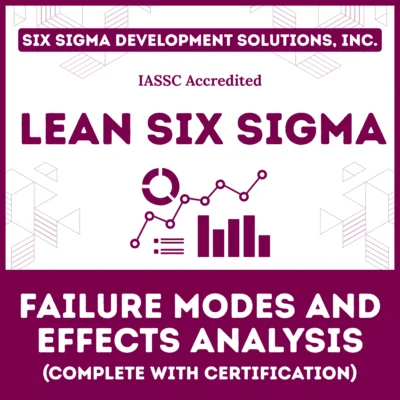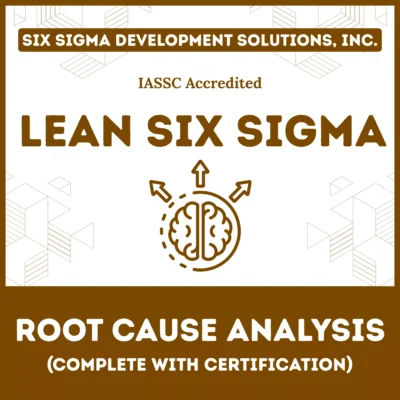Project managers face countless challenges, but perhaps none more critical than managing stakeholder relationships effectively. A stakeholder analysis matrix transforms this complex task into a structured, manageable process that drives project success. This powerful tool helps you identify, categorize, and engage with every person or group who impacts or gets impacted by your project.
Understanding stakeholder dynamics can make or break your project outcomes. The stakeholder analysis matrix provides the framework you need to navigate these relationships strategically, ensuring no critical voice gets overlooked and every engagement effort delivers maximum value.
Key Takeaways:
- Learn to create effective stakeholder analysis matrices
- Discover proven engagement strategies for different stakeholder types
- Avoid common mistakes that derail project success
- Access practical tools and templates for immediate implementation
Table of contents
What Is a Stakeholder Analysis Matrix?
A stakeholder analysis matrix serves as a visual mapping tool that categorizes project stakeholders based on their level of influence and interest in your project. This systematic approach transforms stakeholder management from guesswork into a data-driven strategy.
The matrix typically displays stakeholders on a grid where one axis represents their level of influence or power, while the other shows their level of interest or impact. This visualization immediately reveals which stakeholders require your closest attention and which engagement strategies will prove most effective.
Project managers use this matrix to allocate their limited time and resources wisely. Instead of treating all stakeholders equally, you can focus your energy where it matters most while ensuring no important relationship gets neglected.
The matrix also serves as a communication tool for your project team. Everyone can quickly understand stakeholder priorities and adjust their interactions accordingly. This shared understanding prevents mixed messages and ensures consistent stakeholder engagement across your entire project.
Public, Onsite, Virtual, and Online Six Sigma Certification Training!
- We are accredited by the IASSC.
- Live Public Training at 52 Sites.
- Live Virtual Training.
- Onsite Training (at your organization).
- Interactive Online (self-paced) training,
Why Stakeholder Analysis Matters for Project Success?
Stakeholder analysis directly impacts your project’s success rate. Research consistently shows that projects with effective stakeholder management deliver better outcomes, stay within budget more often, and face fewer unexpected obstacles.
When you understand stakeholder motivations, concerns, and expectations early in your project, you can proactively address potential issues before they escalate. This foresight prevents costly delays and scope changes that derail project timelines.
Stakeholder buy-in accelerates project momentum. When key influencers support your initiative, they become advocates who help overcome resistance and secure necessary resources. Conversely, neglected stakeholders often become obstacles that slow progress and create unnecessary friction.
The analysis process also reveals hidden dependencies and relationships that impact your project. You might discover that a seemingly minor stakeholder actually holds significant sway with decision-makers, or that two stakeholder groups have conflicting interests that require careful navigation.
Effective stakeholder management builds your reputation as a project manager. Stakeholders remember how you treated them during projects, and positive relationships open doors for future initiatives. This professional capital becomes invaluable as your career progresses.
Key Components of an Effective Stakeholder Analysis Matrix

Every effective stakeholder analysis matrix includes several essential elements that ensure comprehensive stakeholder mapping. Understanding these components helps you create matrices that drive real project value.
The influence axis measures each stakeholder’s ability to impact your project’s success. High-influence stakeholders can make decisions that dramatically affect your project scope, budget, timeline, or resources. Low-influence stakeholders have minimal direct impact on project outcomes but may still require communication and updates.
The interest axis evaluates how much each stakeholder cares about your project’s success or failure. High-interest stakeholders closely monitor project progress and actively seek involvement in project decisions. Low-interest stakeholders may be affected by your project but don’t actively engage with project activities.
Stakeholder identification forms the foundation of your matrix. This process involves systematically listing every person, group, or organization that affects or gets affected by your project. Comprehensive identification prevents surprises later when previously unknown stakeholders emerge with concerns or requirements.
Classification categories help organize stakeholders into manageable groups. Common categories include internal versus external stakeholders, primary versus secondary stakeholders, and supportive versus neutral versus resistant stakeholders. These classifications guide your engagement approach for each group.
Also Read: What is Change Impact Analysis?
Types of Stakeholder Analysis Matrices
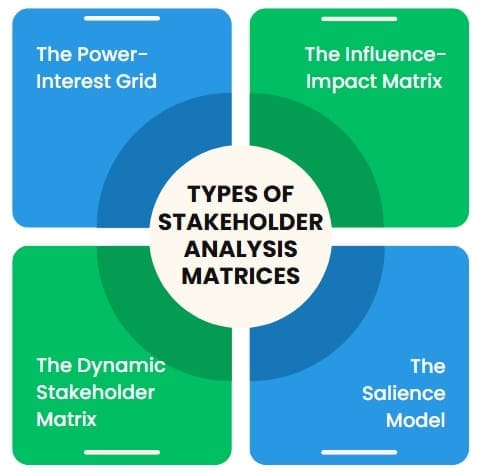
Different matrix formats serve different project needs and contexts. Choosing the right matrix type ensures your analysis provides maximum value for your specific situation.
The Power-Interest Grid represents the most common matrix format. This two-dimensional grid plots stakeholders based on their power to influence project outcomes and their level of interest in project success. Four quadrants emerge: high power/high interest (manage closely), high power/low interest (keep satisfied), low power/high interest (keep informed), and low power/low interest (monitor).
The Influence-Impact Matrix focuses on stakeholder influence and the degree to which your project impacts them. This format works particularly well for projects that create significant organizational or community changes. Stakeholders with high influence and high impact require the most attention and customized engagement strategies.
The Salience Model incorporates three dimensions: power, legitimacy, and urgency. This more complex approach provides nuanced stakeholder categorization but requires more time and analysis. Use this model for highly complex projects with diverse stakeholder groups and competing interests.
The Dynamic Stakeholder Matrix acknowledges that stakeholder positions change throughout project lifecycles. This format includes mechanisms for tracking stakeholder movement between categories as project circumstances evolve. Regular updates ensure your engagement strategies remain relevant and effective.
Step-by-Step Guide to Creating Your Stakeholder Analysis Matrix

Follow these steps to develop a comprehensive matrix that guides successful stakeholder engagement.
Step 1: Identify All Stakeholders
Begin by brainstorming every person, group, or organization connected to your project. Include obvious stakeholders like sponsors and team members, but also consider indirect stakeholders like vendors, regulators, and community groups. Use techniques like stakeholder interviews, organizational charts, and process mapping to ensure comprehensive identification.
Step 2: Gather Stakeholder Information
Collect relevant data about each identified stakeholder. Document their role, responsibilities, expectations, concerns, and preferred communication methods. Interview key stakeholders directly when possible, and gather intelligence through team members and other contacts.
Step 3: Assess Influence and Interest Levels
Evaluate each stakeholder’s ability to impact your project and their level of interest in project outcomes. Use consistent criteria and rating scales to ensure fair comparisons. Consider both formal authority and informal influence when making these assessments. Document your reasoning for future reference and updates.
Step 4: Plot Stakeholders on the Matrix
Place each stakeholder in the appropriate matrix position based on their influence and interest scores. Use clear labels and consistent symbols to ensure easy interpretation. Color coding can help distinguish between stakeholder types or categories. Make sure the final matrix remains readable and actionable.
Step 5: Develop Engagement Strategies
Create specific engagement approaches for each matrix quadrant or stakeholder category. High-influence/high-interest stakeholders require frequent, detailed communication and active involvement in decision-making. Low-influence/low-interest stakeholders need basic updates and monitoring for changes in their position.
Step 6: Review and Update Regularly
Schedule regular matrix reviews to account for changing stakeholder positions and emerging new stakeholders. Project dynamics shift over time, and your matrix must reflect these changes to remain useful. Update engagement strategies as stakeholder positions evolve.
Also Read: What is Eisenhower Matrix?
Best Practices for Stakeholder Matrix Implementation
- Successful stakeholder analysis requires more than just creating a matrix. These best practices ensure your matrix drives meaningful improvements in stakeholder relationships and project outcomes.
- Start your stakeholder analysis early in the project lifecycle. The earlier you understand stakeholder dynamics, the more effectively you can incorporate their needs into project planning. Late stakeholder analysis often reveals conflicts and requirements that necessitate costly project changes.
- Involve your project team in stakeholder identification and analysis. Team members often have valuable insights about stakeholder relationships and concerns that you might miss. Collaborative analysis also ensures team buy-in for the resulting engagement strategies.
- Keep stakeholder information confidential and secure. Stakeholder analysis often involves sensitive information about relationships, concerns, and political dynamics. Protect this information while ensuring authorized team members can access what they need for effective stakeholder engagement.
- Use objective criteria for stakeholder assessment. Personal biases can skew your analysis and lead to ineffective engagement strategies. Develop clear definitions for influence and interest levels, and apply them consistently across all stakeholders.
- Focus on stakeholder value creation. The most effective engagement strategies help stakeholders achieve their own objectives while supporting project success. Look for win-win opportunities that build long-term relationships beyond your current project.
- Document engagement interactions and outcomes. Track which strategies work effectively with different stakeholder types, and capture lessons learned for future projects. This documentation becomes valuable organizational knowledge that improves overall project management capabilities.
Common Mistakes to Avoid
Even experienced project managers make stakeholder analysis mistakes that undermine project success. Recognizing these common pitfalls helps you avoid them in your own projects.
Incomplete stakeholder identification represents the most frequent mistake. Projects often discover overlooked stakeholders late in execution, leading to resistance and delays. Systematic identification processes and regular reviews help prevent this issue.
Static analysis that doesn’t account for changing stakeholder positions creates outdated engagement strategies. Stakeholder interests and influence levels shift throughout project lifecycles, and your matrix must reflect these changes. Schedule regular updates to maintain matrix accuracy.
Over-focusing on obvious stakeholders while neglecting secondary stakeholders can create unexpected problems. Secondary stakeholders sometimes become primary influencers as project circumstances change. Maintain awareness of all stakeholder categories throughout your project.
Inadequate engagement strategy differentiation treats all stakeholders similarly, wasting resources and missing opportunities. Different stakeholder categories require different approaches, and your strategies should reflect these differences clearly.
Failing to communicate matrix insights to your project team reduces the tool’s effectiveness. Team members need to understand stakeholder priorities and engagement strategies to support consistent stakeholder management across all project interactions.
Tools and Templates for Stakeholder Analysis

Various tools and templates can streamline your stakeholder analysis process and improve matrix quality. Selecting appropriate tools depends on your project complexity, team size, and organizational preferences.
- Spreadsheet-based matrices work well for simple projects with limited stakeholders. Standard spreadsheet applications provide sufficient functionality for basic stakeholder tracking and analysis. Templates can standardize the process across multiple projects and team members.
- Specialized project management software often includes stakeholder management features with built-in matrix capabilities. These tools integrate stakeholder analysis with other project management functions, providing comprehensive project visibility and coordination.
- Visual mapping tools create more engaging and intuitive stakeholder matrices. Mind mapping software and diagramming tools help stakeholders understand their positions and relationships more clearly than traditional grid formats.
- Collaborative platforms enable distributed teams to contribute to stakeholder analysis regardless of location. Cloud-based tools ensure everyone works with current information and can see updates in real-time.
- Custom database solutions work best for large, complex projects with extensive stakeholder networks. These systems can track detailed stakeholder information, interaction history, and engagement outcomes across multiple related projects.
Also Read: What is Impact-Effort Matrix?
Measuring Stakeholder Engagement Success
Effective stakeholder management requires measurement and continuous improvement. These metrics help you evaluate engagement effectiveness and optimize your approaches over time.
Stakeholder satisfaction surveys provide direct feedback about engagement quality and effectiveness. Regular surveys track satisfaction trends and identify areas needing improvement. Keep surveys brief and focused on actionable insights.
Communication effectiveness metrics measure how well information reaches stakeholders and generates desired responses. Track metrics like message open rates, response rates, and feedback quality to optimize communication strategies.
Engagement participation levels indicate stakeholder interest and commitment. Monitor attendance at meetings, participation in project activities, and voluntary contribution levels to gauge engagement success.
Issue resolution speed reflects stakeholder relationship quality. Well-engaged stakeholders typically raise concerns early and work collaboratively toward solutions. Track how quickly stakeholder issues get identified and resolved.
Project outcome metrics ultimately demonstrate stakeholder management effectiveness. Projects with superior stakeholder engagement typically deliver better results, stay within budget more often, and face fewer unexpected obstacles.
Final Words
A stakeholder analysis matrix is a vital tool in project management that helps identify, categorize, and prioritize stakeholders based on their influence and interest. It enables effective communication strategies and resource allocation by highlighting key players who impact project success. By systematically understanding stakeholders’ needs and expectations, teams can anticipate challenges, foster collaboration, and ensure alignment with project goals.
Ultimately, the stakeholder analysis matrix enhances decision-making, reduces risks, and promotes smoother project execution through targeted engagement and management.
Frequently Asked Questions on Stakeholder Analysis Matrix
What is a stakeholder analysis matrix?
A stakeholder analysis matrix is a visual tool that categorizes project stakeholders based on their level of influence and interest in your project. It helps project managers prioritize engagement efforts and develop targeted communication strategies for different stakeholder groups.
How often should I update my stakeholder analysis matrix?
Update your stakeholder analysis matrix at key project milestones or when significant changes occur in stakeholder positions. Most projects benefit from monthly reviews, though complex projects may require more frequent updates to maintain accuracy.
What’s the difference between influence and interest in stakeholder analysis?
Influence refers to a stakeholder’s ability to impact project outcomes through decision-making authority or resource control. Interest measures how much the stakeholder cares about project success or gets affected by project results.
How many stakeholders should be included in the matrix?
Include all stakeholders who significantly impact or get impacted by your project. While there’s no fixed number, most project matrices contain 15-30 stakeholders. Focus on quality of analysis rather than quantity of stakeholders.
Can stakeholder positions change during a project?
Yes, stakeholder positions frequently change as projects evolve. New information, changing circumstances, or shifting priorities can alter stakeholder influence and interest levels. Regular matrix updates capture these changes and adjust engagement strategies accordingly.
What engagement strategy works best for high-influence, low-interest stakeholders?
High-influence, low-interest stakeholders require a “keep satisfied” approach. Provide them with concise, relevant updates that respect their time while ensuring they remain informed enough to support project decisions when needed.







